
Halictidae is the second-largest family of bees with nearly 4,500 species. Halictid species are an extremely diverse group that can vary greatly in appearance. These bees occur all over the world and are found on every continent except Antarctica. Usually dark-colored and often metallic, halictids are found in various sizes, colors and patterns. Several species are all or partly green and a few are red, purple, or blue. A number of them have yellow markings, especially the males, which commonly have yellow faces, a pattern widespread among the various families of bees. The family is one of many with short tongues and is best distinguished by the arcuate basal vein found on the wing. Females in this family tend to be larger than the males.

Halictus rubicundus, the orange-legged furrow bee, is a species of sweat bee found throughout the Northern Hemisphere. H. rubicundus was introduced into North America from the Old World during one of two main invasions of Halictus subgenera. These invasions likely occurred via the Bering land bridge at times of low sea level during the Pleistocene epoch.
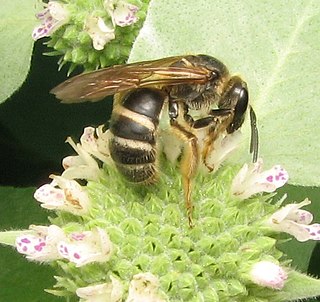
The sweat bee genus Lasioglossum is the largest of all bee genera, containing over 1700 species in numerous subgenera worldwide. They are highly variable in size, coloration, and sculpture; among the more unusual variants, some are cleptoparasites, some are nocturnal, and some are oligolectic. Most Lasioglossum species nest in the ground, but some nest in rotten logs.

The genus Agapostemon is a common group of Western Hemisphere sweat bees, most of which are known as metallic green sweat bees for their color.

Colletes hederae, the ivy bee, is a species of plasterer bee belonging to the family Colletidae subfamily Colletinae.
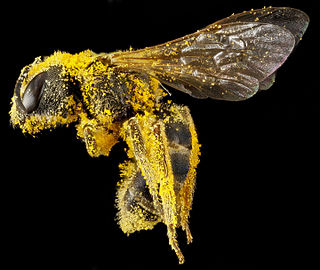
Halictus ligatus is a species of sweat bee from the family Halictidae, among the species that mine or burrow into the ground to create their nests. H. ligatus, like Lasioglossum zephyrus, is a primitively eusocial bee species, in which aggression is one of the most influential behaviors for establishing hierarchy within the colony, and H. ligatus exhibits both reproductive division of labor and overlapping generations.

Sphecodes gibbus, the dark-winged blood bee, is a species of cleptoparasitic blood bee from the Palearctic. It is the type species of the genus Sphecodes and was first described by Carl Linnaeus as Sphex gibba in 1758.

Dialictus is a subgenus of sweat bees belonging to the genus Lasioglossum. Most of the members of this subgenus have a metallic appearance, while some are non-metallic. There are over 630 species worldwide. They are commonly found in the Northern Hemisphere and are found in abundance in North America. Members of this subgenus also have very diverse forms of social structure making them model organisms for studying the social behavior of bees.
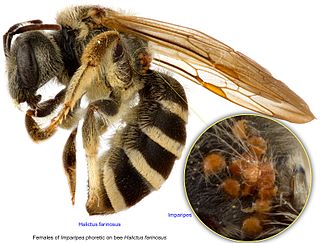
Halictus farinosus is a species of ground-nesting sweat bee in the family Halictidae. The species is a primitively eusocial bee, of intermediate social strength when compared to other social species in the genus Halictus.

Nomiinae is a subfamily of sweat bees in the family Halictidae. There are about 11 genera and at least 550 described species in Nomiinae.
Halictus parallelus is a species of sweat bee in the family Halictidae.

Halictus tripartitus is a species of sweat bee in the family Halictidae.
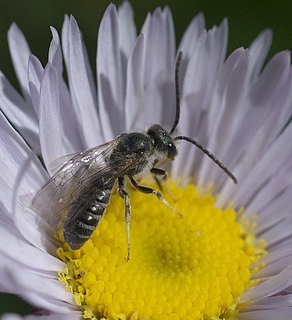
Halictus virgatellus is a species of sweat bee in the family Halictidae.

Halictus confusus, the southern bronze furrow bee or confused sweat bee, is a species of sweat bee in the family Halictidae. It is a primitively eusocial bee species found in open habitats in Eurasia and North America.
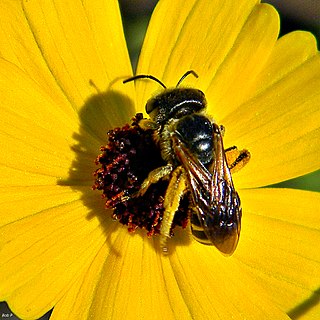
Halictus poeyi, or Poey's furrow bee, is a species of sweat bee in the family Halictidae.
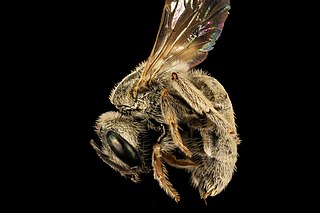
Halictus tectus is a species of sweat bee in the family Halictidae.
Lasioglossum mellipes is a species of sweat bee in the family Halictidae.

Augochlorella aurata is a species of sweat bee in the family Halictidae. It is found in North America east of the Rocky Mountains. The body is a brilliant green metallic color, diffused to varying extents with a copper, red, or yellow color. Its length is 5 to 7 mm. A common name is golden green sweat bee.

Homalictus is a subgenus of bees in the genus Lasioglossum subfamily Halictinae of the family Halictidae. They are found in Sri Lanka, Southeast Asia, east across the Pacific to the Mariana Islands, Samoa, Fiji and are most prevalent in Australia.
Halictus hotoni, Hoton's metallic-furrow bee, is a species of sweat bee in the family Halictidae native to southern Africa and introduced to Australia. It was initially identified as the Emerald metallic-furrow bee It was described by Joseph Vachal in 1903.

















